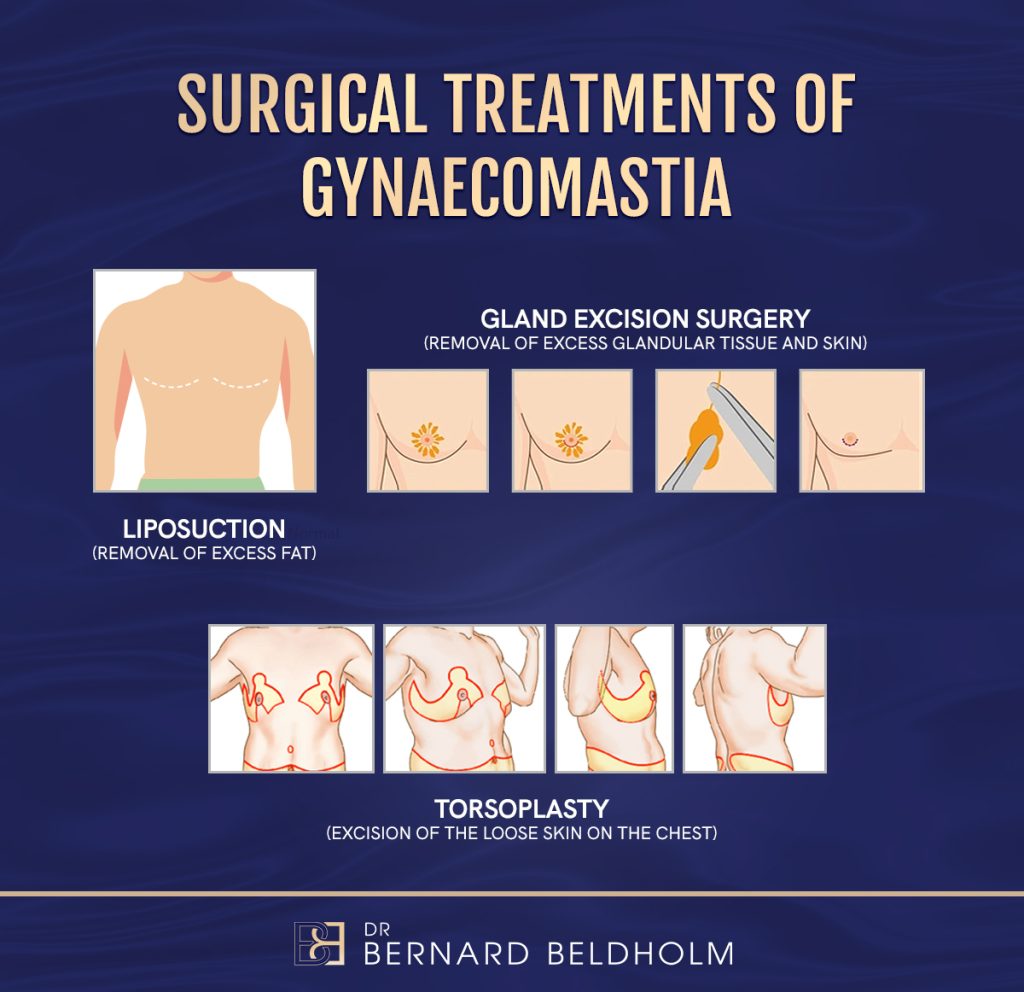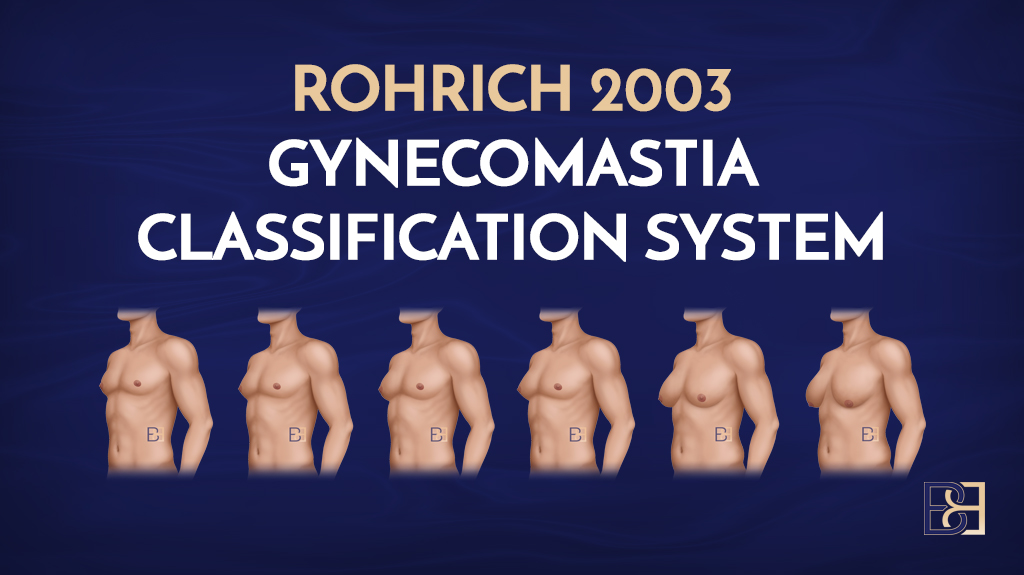Gynaecomastia surgery is a procedure aimed at removing excess breast tissue in men, caused by hormonal imbalances. Candidates should maintain stable body weight and have realistic expectations, while proper preparation and post-operative care play critical roles in recovery and achieving long-lasting results.
Gynaecomastia is a common condition in which men develop enlarged breast tissue due to hormonal imbalances, weight gain, or other factors. For some, this condition resolves on its own, but for others, it may require medical or surgical intervention.
Options range from liposuction (Suction-assisted lipectomy) to gland excision, each suitable for different conditions. First, it’s helpful to understand what gynaecomastia is and why it occurs.
Understanding Gynaecomastia

Disclaimer: Operation performed by Dr Bernard Beldholm. Adult content, surgery has risks; individual results vary, seek 2nd opinion. Please see the full disclaimer.
Book your appointment online now
Gynaecomastia is a condition causing the enlargement of male breast tissue. The root of this issue lies in hormonal imbalances, particularly between testosterone and oestrogen levels. This imbalance can occur at various life stages, like puberty or older age, and can be exacerbated by factors such as excess weight gain, anabolic steroid use, and even certain medications. It’s not just a cosmetic concern; the condition can lead to significant emotional discomfort and social anxiety.
Common symptoms of gynaecomastia include lumps in the breasts, excess fat, and a palpable, tender, firm, mobile, disc-like mound of tissue under the nipple. These symptoms can vary in severity, leading to different levels of discomfort and self-consciousness (ref 1). Some cases resolve on their own, but many persist and require medical or surgical intervention to remove excess breast tissue.
The impact of gynaecomastia goes beyond physical appearance. Men suffering from this condition often experience a significant emotional toll, feeling embarrassed or anxious in social settings (ref 1). Understanding the condition is the first step towards seeking appropriate treatment.
Different Types of Surgery for Gynaecomastia

Several surgical options are available for treating gynaecomastia, each with different aspects of the condition. The most common procedures include liposuction, gland excision, or a combination of both.
Liposuction is a popular choice for men with excess fatty tissue but minimal glandular tissue. This procedure involves making small incisions through which a cannula is inserted to suction out the fat, effectively contouring the male chest. It’s minimally invasive and often preferred for milder cases of gynaecomastia.
In cases where there is more dense glandular tissue, excision is necessary. This involves making an incision, usually around the areola, to remove the glandular tissue. For more severe cases, a combination of liposuction and gland excision might be necessary to achieve the best results. This approach ensures effective removal of both excess fat and glandular tissue, resulting in a more masculine chest appearance.
If there is a significant amount of loose skin associated with gynaecomastia, it needs to be removed as well. Torsoplasty for gynaecomastia is a procedure that removes the loose skin as well as the breast gland tissue and relocates the nipple areola. This procedure is more extensive compared to a subcutaneous mastectomy.

Disclaimer: Operation performed by Dr Bernard Beldholm. Adult content, surgery has risks; individual results vary, seek 2nd opinion. Please see the full disclaimer.
Determining If You’re a Candidate for Surgery
Not everyone is an ideal candidate for gynaecomastia surgery. To be considered, individuals must generally have stable body weight, as fluctuations can impact surgical outcomes. It’s also essential to have realistic expectations about what the surgery can achieve and its limitations. Underlying medical conditions, such as liver disease, kidney failure, and hormonal disorders, should be evaluated and managed before considering surgery.
Factors that might disqualify someone from surgery include being overweight without attempting weight-loss techniques, having unmanaged medical conditions, or struggling with substance abuse. Consulting with a qualified surgeon helps determine the most appropriate approach based on individual circumstances.
Preparing for Male Breast Reduction Surgery

Preparation is key to a successful male breast reduction surgery. One of the most critical steps is quitting smoking, as tobacco use can significantly hinder the healing process and increase the risk of complications. Patients should also avoid aspirin, anti-inflammatory drugs, and herbal supplements, as these can increase bleeding during surgery.
Good overall health is vital, including managing existing medical conditions and following the surgeon’s specific instructions. A comprehensive health evaluation, including blood tests and breast examinations, is usually conducted to understand the underlying causes of gynaecomastia and plan the best course of action.
Proper preparation sets the stage for a smooth procedure and recovery.
VASER Liposuction (Suction-assisted lipectomy) for Pseudo-gynaecomastia

VASER liposuction (Suction-assisted lipectomy) is a technique that utilises ultrasound technology to break down fat cells, making them easier to remove. This procedure is particularly effective for pseudo-gynaecomastia, where the enlargement is primarily due to excess fatty tissue rather than glandular tissue.
The procedure involves small incisions through which the ultrasound probe is inserted to emulsify the fat before it’s suctioned out. General anaesthesia is typically used, ensuring that the patient remains pain-free and unconscious during the operation.
Excision of Breast Gland with VASER Liposuction (Suction-assisted lipectomy)

In cases involving both excess glandular tissue and fatty tissue, a combination of gland excision and VASER liposuction (Suction-assisted lipectomy) can provide the best results. Initially, VASER liposuction (Suction-assisted lipectomy) is performed to remove the surrounding fat. This is followed by the removal of excess breast gland tissue through a small incision in the areola.
This combined approach can be performed as a day procedure or may require an overnight stay, depending on the extent of the surgery. Drains are often placed to facilitate the removal of excess fluid and are typically removed the next day.
This method comprehensively reduces both glandular and fatty tissues, resulting in a more contoured chest.
Torsoplasty for Gynaecomastia with Nipple Areolar Grafts

Torsoplasty with nipple-areolar grafts is a more extensive surgical option reserved for severe cases of gynaecomastia. This procedure involves removing large amounts of excess breast tissue and repositioning the nipples to a more natural location on the chest. General anesthesia is used, and the surgery requires an overnight stay.
The recovery process for torsoplasty is longer, but it can achieve dramatic results for those with significant gynaecomastia. Drains are placed to help manage fluid buildup and are typically removed within a few days.
This technique can significantly change the male chest’s appearance, especially in cases with substantial excess skin and tissue.
Post-Operative Care and Recovery Process
Recovery is a crucial phase of the gynaecomastia surgery journey. Patients typically need to wear a compression garment for at least four weeks after surgery to reduce swelling and promote healing. Pain management is essential, with options ranging from over-the-counter medications to prescribed pain relief, depending on individual needs.
The general recovery timeline spans 4 to 6 weeks, with most patients able to return to work and light activities after about a week. However, it’s important to limit physical activities to light walking for the first few days and gradually increase the intensity as healing progresses. Staying hydrated and maintaining a light diet can also aid in the recovery process.
Six weeks post-surgery, most patients can resume all normal activities, including strenuous exercise. Following the surgeon’s instructions and attending all follow-up appointments ensures a smooth recovery and optimal outcome.
Potential Complications and Risks
Like any surgical procedure, gynaecomastia surgery carries potential risks and complications. Common issues include bruising, bleeding, fluid collections, and visible scarring. While infections are uncommon, they can occur and may require antibiotics or additional surgical intervention.
More severe complications, though rare, include deep vein thrombosis and pulmonary embolus, which can occur during longer procedures. Additionally, some patients might experience contour irregularities or nipple necrosis due to compromised blood supply post-surgery.
Understanding these risks is key to making an informed surgical decision. Discussing any concerns with your surgeon and following all pre- and post-operative care instructions can minimise potential complications.
Long-Term Results and Maintenance
Achieving long-term results from gynaecomastia surgery requires maintaining a stable weight and making healthy lifestyle choices. A diet rich in fruits and vegetables, staying hydrated, and avoiding substances that can cause hormonal imbalances, such as anabolic steroids, are crucial. Regular monitoring of hormone levels can also help prevent the recurrence of gynaecomastia.
Avoiding significant weight fluctuations and engaging in regular physical activity help maintain the results. Adhering to these guidelines ensures the surgery’s benefits are sustained long-term, leading to physical and emotional well-being.
Emotional and Psychological Considerations
Gynaecomastia isn’t just a physical condition; it carries significant emotional and psychological weight (1). Many men feel embarrassed and suffer from social anxiety due to their enlarged breasts. Undergoing surgery can alleviate much of this emotional discomfort.
However, having realistic expectations is important, as surgery is a tool, not a cure-all for emotional issues. Consulting a qualified health practitioner can provide additional support and help manage any lingering emotional discomfort.
Summary

In summary, gynaecomastia surgery offers a viable solution for men struggling with enlarged breasts. Understanding the condition, exploring the various surgical options, and preparing adequately can lead to successful outcomes. Post-operative care and maintaining a healthy lifestyle are crucial for long-term success.
The journey to overcoming gynaecomastia is both physical and emotional. If you’re considering this surgery, consult with a qualified surgeon to discuss your options and embark on this journey.
Frequently Asked Questions
What causes gynaecomastia?
Gynaecomastia happens when there’s an imbalance between testosterone and oestrogen, often caused by hormonal changes, being overweight, or certain medications.
What are the different types of gynaecomastia surgery?
The main types of gynaecomastia surgery are liposuction, gland excision, or a combo of both. It really depends on your situation and what suits you best!
What should I do to prepare for male breast reduction surgery?
To get ready for male breast reduction surgery, focus on quitting smoking, steering clear of specific medications, and staying healthy overall. Being in good shape can really help your recovery!
What is VASER liposuction (Suction-assisted lipectomy) and how does it work?
VASER liposuction (Suction-assisted lipectomy) is a technique that uses ultrasound to break down fat cells, making them easier to remove.
References
- Nuzzi LC et al. “Psychosocial impact of adolescent gynecomastia: a prospective case-control study.”, Plastic & Reconstructive Surgery. 131(4):890-896, 2013 Apr.




